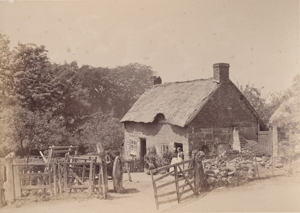
|
Agriculture and Rural LivesIn terms of geographical area, Staffordshire still remains a rural county. A hundred years earlier, farming was the major employer, with a combination of smallholdings, small private farms, and large estates containing many leasehold farms as well as its own "home farm". Every farm would have had agricultural and domestic workers, some permanent and some seasonal, to carry out animal husbandry, labouring work, and to assist the farmer's wife with dairy produce, which could be sold at the local market towns or at seasonal fairs. But simple cottagers would also be hoping to produce some of their own food or drink and were thus all involved in the local rural economy. Neighbours would help each other out with labour or produce and, at times of the main harvests, all spare hands would be called in to assist. This would also include the children, who would miss school if necessary to help their parents or neighbours. In a rural area this was an accepted part of the school year. During periods of agricultural depression there was not enough paid work and times could be very hard. The unemployed tended to drift away to the towns and cities looking for other work. Like the poor urban areas, rural housing could be rudimentary and living conditions cramped and primitive, although the larger estates tended to be more aware of the need to maintain their tenants' cottages and had the money to finance this. The process of enclosure had a great impact on this during the eighteenth and early nineteenth centuries, by benefitting larger estates and reducing the grazing or foraging land available to small-holders or cottagers. Those with the financial resources were also in a position to make more improvements to the land, or to get the value of an extra tenancy by exploiting poorer quality land. From the mid-nineteenth century great advances were made with the help of greater industrialisation: in tool manufacturing from the metal industries; improved drainage and buildings from the brick and tile industries; and better cattle feed and land fertilisation, assisted by the new transport options from the railways. More land was converted from arable farming to pasture, as livestock was more profitable than crops. |
